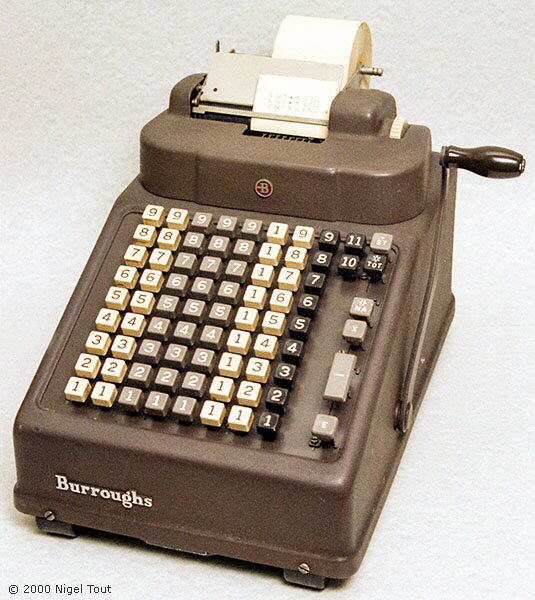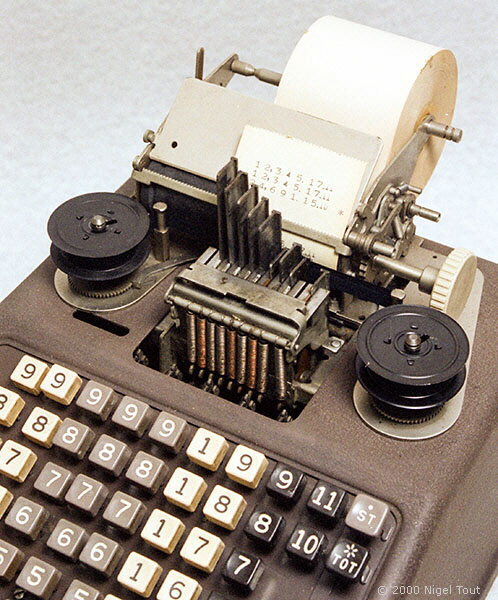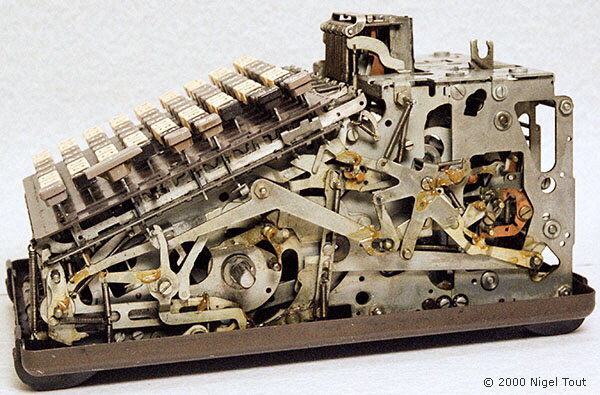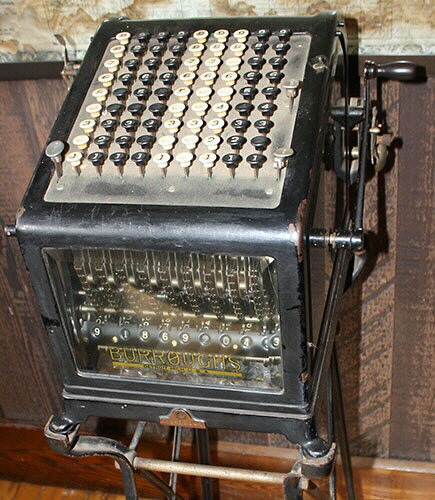Burroughs Add-lister

Burroughs Full-keyboard Add-lister
Burroughs specialised in 'add-lister' mechanical calculators. That is primarily an adding machine, though it can be used for subtraction and multiplication, which prints each number entered, and sub-totals and totals on the listing paper for a permanent record. It has a 'full-keyboard' with numbers 0 to 9 in each decade. This allows faster operation since all of the digits of a number can be entered and latched in simultaneously using multiple fingers, before pulling the lever to perform the addition or subtraction. This is in contrast to the '10-key add-listers' where the digits of a number are entered in sequence.
This example is serial number P10230 S. It was made in Strathleven, Scotland (with "parts made in U.S. America") in the 1950s/60s.
Note the nine "1" keys in the 10's of shillings column - 19 is the maximum number of shillings - and the extra "10" and "11" pence keys.
290 mm wide, 340 mm long, 225 mm high (11.5" x 13.5" x 9"), 9 Kg (20 lbs.).

The print head during the printing operation.
There is a print bar for each column of keys. Each print bar has all the digits in order. When the handle is pulled forwards to print the number keyed in, and add it to the accumulator, the print bars rise to different heights to impact the keyed digits on the paper.

With the cover removed some of the mechanical complexity of this type of machine can be appreciated.
Burroughs 'visible' add-lister

Burroughs 'visible' add-lister
Dating from early in the 20th century, this full-keyboard mechanical adding machine prints the calculations on a paper roll at the rear.
The keys latch in, allowing the entered number to be checked, until the lever is pulled which enters the number into the accumulator and prints it, or prints the total or subtotal.
The glass panels allow the mechanism to be seen operating.
Cropped from an image attributed to Royalbroil, CC BY-SA 3.0 https://creativecommons.org/licenses/by-sa/3.0, via Wikimedia Commons
The add-lister type of machine, as shown here, is much slower in use than the "Comptometer" type of machine since the handle has to be pulled forward to add (or subtract) each number entered in order to print it - though it does have the advantage of producing a printed record of all calculations which is useful for producing a permanent record.
Originally invented by William Seward Burroughs in the 1880s the Burroughs add-listers proved very successful and sold widely to companies, especially for use in accounting departments. These machines were not intended to be personal calculators and were large and expensive. Add-listers were developed and manufactured in large numbers into the early 1970s where they were displaced in companies as much by computers as by electronic calculators.
Michael Hancock has produced an interesting history of the Burroughs Adding Machine Company and its calculators at http://www.xnumber.com/xnumber/hancock7.htm.
See also "Burroughs Adding Machine History": A film on YouTube which shows Burroughs adding and accounting machines, and computers being manufactured and used at https://www.youtube.com/watch?v=ZBkZI0jYi3I.
Information about the development of the Burroughs mechanical calculators, with an emphasis on the British operations, can be found in the book:
"Total to Date: The Evolution of the Adding Machine: The Story of Burroughs",
by Bryan Morgan, published in 1953 by Burroughs Adding Machine Limited London.
Around 1970 Burroughs moved into the sale and manufacture of electronic desktop calculators, with the Burroughs C3155, C3260, and C5205 being featured on this website.
Mechanical Calculators
Vintage Calculators
Text & photographs copyright, except where stated otherwise, © Nigel Tout 2000-2025.